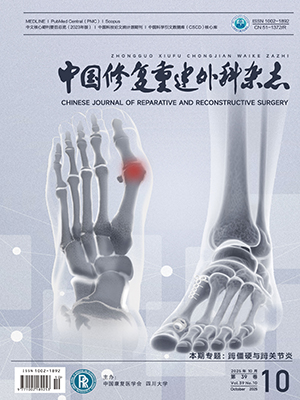| 1. |
Herterich V, Hofmann L, Böcker W, et al. Acute, isolated fractures of the metatarsal bones: an epidemiologic study. Arch Orthop Trauma Surg, 2023, 143(4): 1939-1945.
|
| 2. |
Petrisor BA, Ekrol I, Court-Brown C. The epidemiology of metatarsal fractures. Foot Ankle Int, 2006, 27(3): 172-174.
|
| 3. |
Straus SA, Henry JD, Clements JR. Metatarsal fractures. Clin Podiatr Med Surg, 2024, 41(3): 379-389.
|
| 4. |
Pflüger P, Zyskowski M, Völk C, et al. Functional outcome of 111 metatarsal fractures following conservative in comparison to operative treatment. Unfallchirurg, 2022, 125(4): 288-294.
|
| 5. |
Ayoglu N, Afacan MY, Ozsahin MK, et al. Match the metatarsal heads: A case of all-metatarsal fractures after a motorcycle accident. Cureus, 2023, 15(5): e39659. doi: 10.7759/cureus.39659.
|
| 6. |
Mereddy PK, Molloy A, Hennessy MS. Osteochondral fracture of the fourth metatarsal head treated by open reduction and internal fixation. J Foot Ankle Surg, 2007, 46(4): 320-322.
|
| 7. |
Zarei M, Bagheri N, Nili A, et al. Closed antegrade/retrograde intramedullary fixation of central metatarsal fractures: Surgical technique and clinical outcomes. Injury, 2020, 51(4): 1125-1129.
|
| 8. |
陈绵, 谢广中, 梅林军, 等. 微型钢板内固定对多发跖骨骨折的愈合时间及功能影响. 实用手外科杂志, 2021, 35(1): 106-108.
|
| 9. |
臧建成, 袁福禄, 刘国强, 等. 微型外固定架在足部损伤中的应用. 中国矫形外科杂志, 2010, 18(6): 524-526.
|
| 10. |
McKenzie JC, Rogero RG, Khawam S, et al. Incidence and risk factors for pin site infection of exposed Kirschner wires following elective forefoot surgery. Foot Ankle Int, 2019, 40(10): 1154-1159.
|
| 11. |
白继岳, 徐永清, 何晓清, 等. 镍钛形状记忆合金生物相容性及其表面改性研究进展. 中国修复重建外科杂志, 2018, 32(8): 1091-1095.
|
| 12. |
章云童, 张春才, 付青格, 等. 镍钛合金记忆弓齿钉在粉碎性肩胛骨骨折治疗中的应用. 中华创伤骨科杂志, 2012, 14(7): 553-556.
|
| 13. |
Ibrahim DA, Swenson A, Sassoon A, et al. Classifications In brief: The Tscherne classification of soft tissue injury. Clin Orthop Relat Res, 2017, 475(2): 560-564.
|
| 14. |
Niki H, Aoki H, Inokuchi S, et al. Development and reliability of a standard rating system for outcome measurement of foot and ankle disorders Ⅱ: interclinician and intraclinician reliability and validity of the newly established standard rating scales and Japanese Orthopaedic Association rating scale. J Orthop Sci, 2005, 10(5): 466-474.
|
| 15. |
Tornetta Ⅲ P, W Ricci, MM McQueen. 67 fractures and dislocations of the midfoot and forefoot//Thomas A, Schildhauer MFH. Rockwood and green’s fractures in adults. 9th eds. Lippincott Williams & Wilkins, 2019: 4823-4831.
|
| 16. |
Sarpong NO, Swindell HW, Trupia EP, et al. Republication of “Metatarsal fractures”. Foot Ankle Orthop, 2023, 8(3): 24730114231193428. doi: 10.1177/24730114231193428.
|
| 17. |
Rammelt S, Heineck J, Zwipp H. Metatarsal fractures. Injury, 2004, 35 Suppl 2: SB77-SB86.
|
| 18. |
张春才, 许硕贵, 王家林, 等. 髋臼骨折记忆合金三维内固定系统的设计与临床应用. 中华骨科杂志, 2002, 22(12): 709-713.
|
| 19. |
Liu X, Xu S, Zhang C, et al. Application of a shape-memory alloy internal fixator for treatment of acetabular fractures with a follow-up of two to nine years in China. Int Orthop, 2010, 34(7): 1033-1040.
|
| 20. |
罗一林, 崔进, 谢杨, 等. 形状记忆弓齿钉与下胫腓固定螺钉治疗Maisonneuve骨折的疗效对比. 海军军医大学学报, 2023, 44(11): 1361-1365.
|
| 21. |
Egrise F, Bernard E, Galliot F, et al. Treatment of two or more metatarsal fractures. Orthop Traumatol Surg Res, 2024, 110(1): 103285. doi: 10.1016/j.otsr.2022.103285.
|




